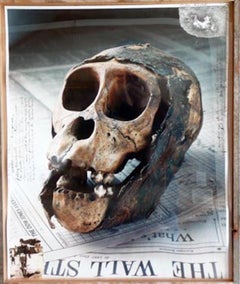Rwanda Skull
Recent Sales
1980s American Realist Color Photography
Archival Paper
Peter Beard for sale on 1stDibs
Reckless, uninhibited and brazen, photographer Peter Beard was, as The Washington Post put it, “as wild as the animals he photographed.” Beard produced some of the most beautiful images of wildlife ever captured on film.
Beard was born in 1938 in New York City. His great-grandfather was James J. Hill, founder of the Great Northern Railway. As a child, he spent his summers at his grandmother’s Tuxedo Park estate, where she gave him his first camera, a Voightländer. He used it to take pictures to accompany his diaries; Beard was a keen diarist throughout his life, amassing more than 100 volumes. At the age of 17, he took a life-changing trip to Africa with Quentin Keynes, Charles Darwin’s great-grandson, using his Voightländer to photograph wildlife.
After attending prestigious private schools such as Buckley and Pomfret, Beard entered Yale University in 1957 as a pre-med student. However, he soon turned his attention toward art, studying under architectural historian Vincent Scully, German artist Josef Albers and painter Richard Lindner. He graduated in 1961 with a degree in art history.
In the 1960s, Beard returned to Africa, where he met Out of Africa author Karen Blixen. Enamored by the continent’s natural beauty, he purchased Hog Ranch near Blixen’s coffee plantation in Kenya. While there, he received a special dispensation from President Uhuru Kenyatta to film, photograph and document the flora and wildlife at Tsavo National Park. This led to The End of the Game, published in 1965, which documented the demise of more than 35,000 starving elephants and 5,000 black rhinos.
Beard became renowned for his black-and-white and color photography, figurative photos and landscapes. He exhibited around the world, including at New York’s Blum Helman Gallery in 1975, the International Center of Photography in Manhattan in 1977, the Centre National de la Photographie in Paris in 1996 and Guild Hall in East Hampton in 2016.
Beard died in 2020 at the age of 82. His works remain in demand with collectors.
On 1stDibs, find original Peter Beard photography, mixed media work and prints.
Finding the Right black-white-photography for You
There’s a lot to love about black and white photography.
The unique and timeless quality of a black and white photograph accentuates any room. Some might argue that we’re naturally drawn to color photography because it’s the world we know best. This is a shared belief, particularly in the era of camera-phone photography, editing apps and the frenetic immediacy of sharing photos on social media. But when we look at black and white photography, we experience deep, rich shadows and tonal properties in a way that transfixes us. Composition and textures are crisp and engaging. We’re immediately drawn to the subjects of vintage street photography and continue to feel the emotional impact of decades-old photojournalism. The silhouettes of mountains in black and white landscape photography are particularly pronounced, while portrait photography and the skylines of urban cityscapes come to life in monochrome prints.
When decorating with fine photography, keep in mind that some color photographs may not be suitable for every space. However, you can be more daring with black and white photos. The gray tones are classic, sophisticated and generally introduce elegance to any corner of your home, which renders black and white prints amazingly versatile.
Black and white photography adapts to its surroundings like a chameleon might. A single large-scale black and white photograph above the sofa in your living room is going to work with any furniture style, and as some homeowners and designers today are working to introduce more muted tones and neutral palettes to dining rooms and bedrooms, the integration of black and white photography — a hallmark of minimalist decor — is a particularly natural choice for such a setting.
Another advantage to bringing black and white photography into your home is that you can style walls and add depth and character without worrying about disrupting an existing color scheme. Black and white photographs actually harmonize well with accent colors such as yellow, red and green. Your provocative Memphis Group lighting and bold Pierre Paulin seating will pair nicely with the black and white fine nude photography you’ve curated over the years.
Black and white photography also complements a variety of other art. Black and white photos pair well with drawings and etchings in monochromatic hues. They can also form part of specific color schemes. For example, you can place black and white prints in colored picture frames for a pop of color. And while there are no hard and fast rules, it’s best to keep black and white prints separate from color photographs. Color prints stand out in a room more than black and white prints do. Pairing them may detract attention from your black and white photography. Instead, dedicate separate walls or spaces to each.
Once you’ve selected the photography that best fits your space, you’ll need to decide how to hang the images. If you want to hang multiple photos, it’s essential to know how to arrange wall art. A proper arrangement can significantly enhance a living space.
On 1stDibs, explore a vast collection of compelling black and white photography by artists such as Mark Shaw, Jack Mitchell (a photographer you should know), Berenice Abbott and David Yarrow.
